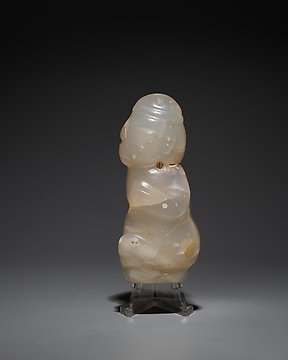
Mixteca, Mexic Onix Figura pandantiv. secolele X-XIII d.Hr. 8,5 cm lungime. Licență de export spaniolă.
Nr. 80568991

Nr. 80568991

Vishnu Sculpture
- Very Nice Quality -
- Important Piece! -
Khmer, Cambodia, 12th century AD.
Sandstone.
180 cm Height
Condition: Good condition. Fracture lines are located on the right shoulder and left thigh. See photos.
Provenance: Private collection, Birdport, UK. 1970.
Description:
A round sculpture in sandstone, probably representing the god Vishnu. Outside India, this divinity acquires his own attributes, as can be seen in this Cambodian piece. This god is usually represented as a human being with blue skin and four arms holding the lotus flower, a conch shell, a golden mace and a ring. He is often seen seated, resting on a lotus flower, with his consort Laksmi sitting on one of his knees. In this case, his face exudes serenity, given the symmetry of his features. The earlobes are elongated, symbolising wisdom and aristocratic origin. It is a stylised piece and the delicacy of the modelling is concentrated in the cloth covering her legs, as well as in the headdress, which is carved with fine incisions and arabesques.
Due to the stylistic characteristics of the material treatment this sculpture belongs to the Khleang style developed in the Angkor period. The Khleang are two buildings of unknown purpose on the east side of the Royal Plaza at Angkor and have given their name to the Khleang style, which is characterised by relatively simple lintels with a central kala and in the case of the sculpture is characterised by the depiction of a modelled anatomy of an idealised character character characterised by stylisation.
Khmer is one of the most important cultures to have developed in Indochina. The first inscriptions in their language appear in the early 7th century in the Indian kingdom of Tshenla, located in the middle reaches of the Mekong River. The Khmers reorganised politically and in the 9th century achieved the unity of present-day Cambodia under Jayavarman II (802-850), founder of the kingdom of Angkor. Jayavarman II had spent his youth at the refined court of the Javanese Sailendra and brought to his country a strong influence of Javanese culture and Javanese court etiquette. Khmer art reached its height of splendour during the Angkor period between the 9th and 13th centuries in a wide range of fields, including textiles, lacquerware, ceramics, goldsmithing, and so on. Khmer sculpture began to break away from the Indian influence from the 7th century onwards and, after a long process of stylistic evolution, developed its own original language, which was consolidated in the 10th century. It was mainly carved in stone and with religious themes, although on many occasions the sacred theme became a mere excuse for depicting court scenes, even if they featured gods. Hence the greater degree of realism compared to Indian art, since the artists took royal courtiers as their models. The result is admirable images of gods of imposing presence, endowed with a certain feminine sensuality and sophisticated beauty.
Notes:
- The piece includes authenticity certificate.
- The piece includes Spanish Export License (Passport for European Union) - If the piece is destined outside the European Union a substitution of the export permit should be requested, can take between 1-2 weeks maximum.
- The seller guarantees that he acquired this piece according to all national and international laws related to the ownership of cultural property. Provenance statement seen by Catawiki.
#ExclusiveCabinetofCuriosities
#asiantribalexclusive
Cum să cumperi de la Catawiki
1. Descoperă ceva special
2. Plasează cea mai mare ofertă
3. Fă o plată sigură